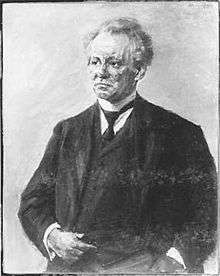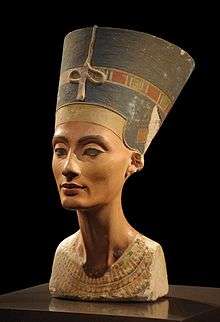Ludwig Borchardt
Ludwig Borchardt (October 5, 1863 – August 12, 1938) was a German Egyptologist who was born in Berlin. He is best known for finding a famous bust of Nefertiti at Amarna.
Ludwig Borchardt | |
|---|---|
 | |
| Born | October 5, 1863 |
| Died | August 12, 1938 (aged 74) |
| Nationality | German |
| Occupation | Egyptologist |
Life

Also known as Herbert, Borchardt initially studied Architecture and later Egyptology under Adolf Erman. In 1895 he journeyed to Cairo and produced, with Gaston Maspero, the Catalogue of the Egyptian Museum (Catalogue Général du Musée du Caire).[1]
His main focus was Ancient Egyptian architecture. He began excavations in Amarna, where he discovered the workshop of the sculptor Thutmose. Amongst its contents was the famous bust of Nefertiti, (now in the Neues Museum in Berlin). From 1902 until 1908, he undertook extensive excavations of the Pyramid of Sahure, exploring the entire mortuary complex. He published his discoveries in a two-volume study Das Grabdenkmal des Konigs Sahure, "The Funerary Monument of the King Sahure", which is still considered the standard work on Sahure's complex.[2]
Borchardt married Emilie (Mimi) Cohen, one of the daughters of Eduard Cohen and Ida Kuhn. In 1903, Mimi received an inheritance from her grandfather Abraham Kuhn of 150,000 Marks, a considerable fortune equal to 53.7 kilograms of gold, and spent most of it on buying a villa in Cairo.[3]
In 1907 Borchardt founded the German Archaeological Institute (Deutsches Archäologische Institut) in Cairo, and remained its director until 1928.[1] While based in Cairo, he also directed the excavations in Heliopolis and the noble tombs of the Old Kingdom in Abu Gorab. He died in Paris on August 12, 1938.
Recently, controversy has arisen with the assertion that Borchardt smuggled the bust of Nefertiti out of Egypt by reporting it as an artifact made of gypsum. However, the Swiss art historian Henri Stierlin has claimed that the bust is a copy dating from 1912.[1][4]
Publications
- Baugeschichte des Amontempels von Karnak (1905)
- Die Annalen und die zeitliche Festlegung des Alten Reiches der ägyptischen Geschichte (1917)
- Quellen und Forschungen zur Zeitbestimmung der Ägyptischen Geschichte, 3 volumes (1917-1938)
See also
References
| Wikimedia Commons has media related to Ludwig Borchardt. |
- Herbert Ricke (1955), "Borchardt, Ludwig", Neue Deutsche Biographie (NDB) (in German), 2, Berlin: Duncker & Humblot, pp. 455–456
- Ludwig Borchardt: Das Grabdenkmal des Königs Sahurā. 2 Bände, J. C. Hinrichs, Leipzig 1910–1913 (Publication of Borchardt's excavations). Online version
- Cilli Kasper-Holtkotte, Deutschland in Ägypten: Orientalistische Netzwerke, Judenverfolgung und das Leben der Frankfurter Jüdin Mimi Borchardt (2017), p. 17 & p. 21, footnote 34
- Famed Nefertiti bust 'a fake': expert